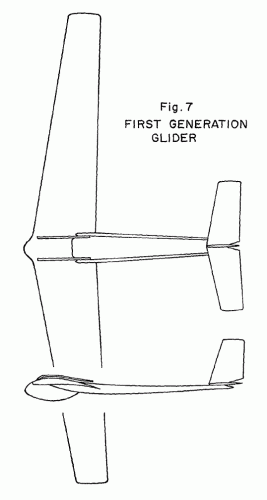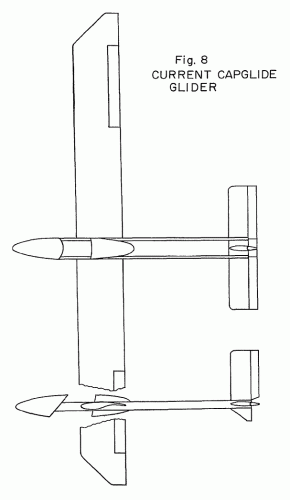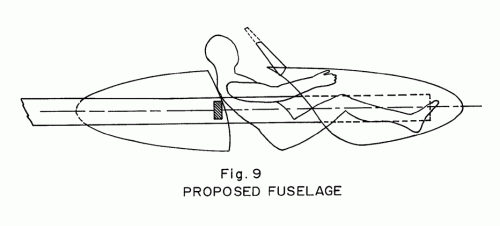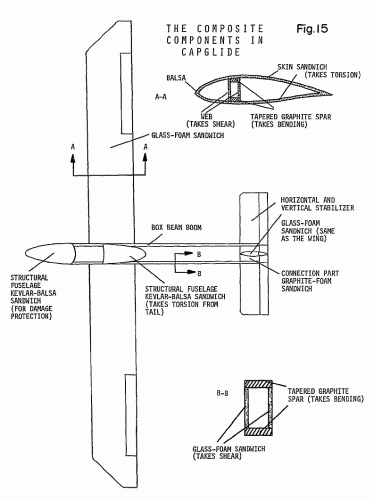- Joined
- 25 June 2009
- Messages
- 14,108
- Reaction score
- 4,239
The CAPGLIDE glider project was part of a larger 1978 project by the Rensselaer Polytechnic Institute called the Composite Structural Program, which comprised three parts:
Initial configuration
Final configuration
Source:
COMPOSITE STRUCTURAL MATERIALS
Air Force Office of Scientific Research
and National Aeronautics and Space Administration
Rensselaer Polytechnic Institute
December 1978
- CAPCOMP (Composite Aircraft Program Component)
- CAPGLIDE (Composite Aircraft Program Glider)
- COMPAD (Computer Aided Design)
This undergraduate demonstration project is to design, fabricate and test an ultralight glider using composite structures. Students will obtain direct "hands-on" experience in advanced composite structures which can serve as a springboard for the more sophisticated CAPCOMP projects. In dealing with the design of a complete vehicle, the effect of any given change on other aspects must be dealt with. In this way the project also requires students majoring in aeronautical, mechanical and materials engineering to interact in much the same way as they do in industry.
Initial configuration
A flight vehicle was selected to maximize student interest and to provide the students with a broad-based engineering experience. The progress on the CAPGLIDE project to date has been very satisfactory. Four professors and approximately 35 students were actively engaged in the project during the beginning of this period; that is, prior to the end of the Spring semester. Our first "NASA/AFOSR Visiting Associate", Dr. Gunter Helwig, joined the project at that time, bringing a wealth of experience as Akaflieg advisor at the Technical University of Darmstadt. With Dr. Helwig here, faculty and staff made a detailed review of the CAPGLIDE status over the summer. (...)
An ultra-light sailplane was selected as the first demonstration project because a full scale flight vehicle would maximize student interest and would be of relative simplicity and low cost to build. (...)
The ultra-light sailplane project has moved into the detail design and fabrication phase. Student activity during the present contract period focused on detail design and analysis of the first version of the aircraft. Faculty and research staff supervised these efforts and, when student involvement decreased during the summer recess, also addressed the problem of modifying the original design to meet specifications. Such modification became necessary as early design estimates were replaced by more accurate predictions, achieved in part by the student design teams and in part through the addition to the project staff of fabrication specialists. (...)
The final full-scale mockup of the prone-pilot version of the aircraft center section has been fabricated. The mockup is complete, with operating control fixtures and pilot harnessing in place. The fully equipped mockup is ready for use in static and dynamic simulation of launch and landing procedures, for testing the layout and accessibility of the control fixtures in all pilot attitudes and for assessing overall quality and comfort of pilot accommodations.
Final configuration
(...) while the student design teams completed their analysis of the initial version, the faculty and research staff involved with the project during the summer recess reexamined the design and modified it substantially. The original D-box wing structure, starting at the wing leading edge, which carried both principle bending and torsion loads-was replaced by a box-spar at 40% chord carrying primarily bending only. This change, with its farther aft carry-through structure, permits the pilot now to be placed reclining with his shoulders within the forward root section of the wing. The necessity for wing sweep to achieve acceptable static margin was thus eliminated. For ease of fabrication, the wing was further made essentially untapered, with a tip-taper to minimize tip losses. Furthermore, wing area was reduced almost 20% to keep the weight down (see Figures 7 and 8). An open, lightweight fuselage shell was added around the reclining pilot to restore the performance lost in some of these changes. Whereas the earlier design depended on wing D-spar structure ahead of the pilot for nose impact protection, the new design uses an extension of the tail booms for this purpose (Figure 9). (...)
The aircraft as modified in the new design remains a foot-launched ultra-light sailplane, with a cantilever stressed skin wing and a twin boom fuselage.
Source:
COMPOSITE STRUCTURAL MATERIALS
Air Force Office of Scientific Research
and National Aeronautics and Space Administration
Rensselaer Polytechnic Institute
December 1978




